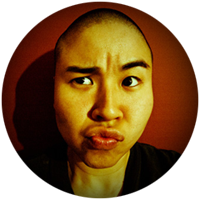The most basic 101 you’ll read of Japanese. Why? Well, because I’m writing it, and I am pretty sure I don’t cover the basics… but I try my best to, so if I can do it – you all can. The basic stuff that is~~~
My background? Let’s see… when I was little (maybe 5 years old) I heard Sukiyaki. Hahaha – that’s my only memory of Japanese then. Then… because of some friends I did my venture with JPop without much success. However, I always sort of liked Japanese… after all TNP (Television Nacional del Peru) always showed NHK educational-dubbed programs.
In 2006 I did a crash course (is that how it’s called?) of Japanese. That means, I studied a month of Japanese and basic grammar… then stopped. And came back to it after getting all Japanese cinema crazy, haven’t stopped since then.
First, my most trusted tool. Rikaichan~
Though it requires your basic skill of Japanese… meaning Hiragana and Katakana reading. Well, if you want to know how the Kanji is read, they only display that way. However, if you are in to just ‘get it’ – it will be useful alongside the following.
- Google Translate – Japanese -> Any Language (preferably English)
- Kanji Dictionary [eng]
- Japanese-English Dictionary [eng]
- Japanese-English Dictionary [jp]
- Japanese Romanization Tool
The rest is up to interpretation, LOL’
The most basic thing is to always remember that in Japanese, the verb is ALWAYS at the end of the sentence. Also to remember? The subject of the sentence is always marked by “wa” which in Hiragana ends up as the “symbol” of “ha” – but it’s always read as “wa”.
The whole particle and marking your sentence gets complicated, but remember:
- “ni” is most likely marking a place where you’re “in”.
- “e” with the symbol of “he” is mostly marking a place “to” where you’re going.
I’ve also seen it being used for letters. Like “To Amy… EIMI he“ - “na” is most likely used to put emphasis or an emotion.
- “ka” is used to indicate question. – as in “daijoubu ka?” – are you okay?
- “no” is often used for possessive.
- “de” is often use to mark the way you’re doing something
as in “nihongo de asobo” – playing in Japanese.
Then, I’m all fuzzy on the object particles~~~
- “o” with hiragana “wo” is to mark the direct object of the sentence.
- “ga” is to mark the object too. LOL but kind of like a subject too.
hahaha, I told you that was fuzzy. I actually don’t know the difference between “anata o sukidesu” to “anata ga sukidesu” – do you?
*sighs* and just writing this bit tires me and confuses me back. LOL – if you really DO feel like reading more about confusing Japanese particles, you can do so here… which I should be re-reading too.
The thing is… Japanese grammar IS complicated, but what Japanese has in some sort of advantage to Chinese is Hiragana and Katakana – though I beg to differ with some Katakana words. Moreover, apparently one can sound smarter in Japanese by using short sentences… which can bring a lot of confusion and misunderstandings, but if you’re “smart” you’ll get it! LOL
The good thing about that is that you’ll understand things like “daijoubu ka? – hai, daijoubu dakara.” as saying “are you okay? – yes, I’m fine.” instead of the silly sounding “good? yes, good.” LOL
Things that confuse me about Japanese? Numbers. Like 200-hyaku – is that 200 thousand? 200 000? I always get confused. Because hyaku is hundred, so 200 hundreds doesn’t compute with me. I get confused as I think I suck at math.
More confusing? Japanese Emperor era and dates. That’s too much knowledge for my little brain. LOL’
I also don’t understand how some kanji are read one way or the other… like “mizu” as in water… but it can also be read “sui” – WHY? Is it like common knowledge, so you just know how to read it? Or is there a rule?
Well, this turned out to be more of my guide of what I find confusing about Japanese than a helpful guide to it, but hopefully the links I provided are helpful to you as they are to me.

